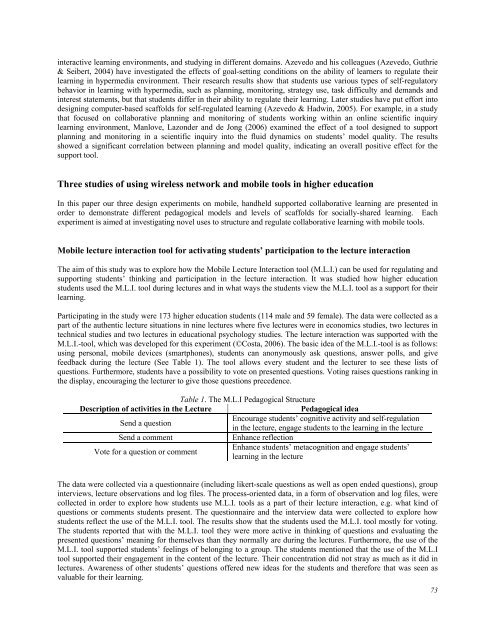October 2007 Volume 10 Number 4 - Educational Technology ...
October 2007 Volume 10 Number 4 - Educational Technology ...
October 2007 Volume 10 Number 4 - Educational Technology ...
You also want an ePaper? Increase the reach of your titles
YUMPU automatically turns print PDFs into web optimized ePapers that Google loves.
interactive learning environments, and studying in different domains. Azevedo and his colleagues (Azevedo, Guthrie<br />
& Seibert, 2004) have investigated the effects of goal-setting conditions on the ability of learners to regulate their<br />
learning in hypermedia environment. Their research results show that students use various types of self-regulatory<br />
behavior in learning with hypermedia, such as planning, monitoring, strategy use, task difficulty and demands and<br />
interest statements, but that students differ in their ability to regulate their learning. Later studies have put effort into<br />
designing computer-based scaffolds for self-regulated learning (Azevedo & Hadwin, 2005). For example, in a study<br />
that focused on collaborative planning and monitoring of students working within an online scientific inquiry<br />
learning environment, Manlove, Lazonder and de Jong (2006) examined the effect of a tool designed to support<br />
planning and monitoring in a scientific inquiry into the fluid dynamics on students’ model quality. The results<br />
showed a significant correlation between planning and model quality, indicating an overall positive effect for the<br />
support tool.<br />
Three studies of using wireless network and mobile tools in higher education<br />
In this paper our three design experiments on mobile, handheld supported collaborative learning are presented in<br />
order to demonstrate different pedagogical models and levels of scaffolds for socially-shared learning. Each<br />
experiment is aimed at investigating novel uses to structure and regulate collaborative learning with mobile tools.<br />
Mobile lecture interaction tool for activating students’ participation to the lecture interaction<br />
The aim of this study was to explore how the Mobile Lecture Interaction tool (M.L.I.) can be used for regulating and<br />
supporting students’ thinking and participation in the lecture interaction. It was studied how higher education<br />
students used the M.L.I. tool during lectures and in what ways the students view the M.L.I. tool as a support for their<br />
learning.<br />
Participating in the study were 173 higher education students (114 male and 59 female). The data were collected as a<br />
part of the authentic lecture situations in nine lectures where five lectures were in economics studies, two lectures in<br />
technical studies and two lectures in educational psychology studies. The lecture interaction was supported with the<br />
M.L.I.-tool, which was developed for this experiment (©Costa, 2006). The basic idea of the M.L.I.-tool is as follows:<br />
using personal, mobile devices (smartphones), students can anonymously ask questions, answer polls, and give<br />
feedback during the lecture (See Table 1). The tool allows every student and the lecturer to see these lists of<br />
questions. Furthermore, students have a possibility to vote on presented questions. Voting raises questions ranking in<br />
the display, encouraging the lecturer to give those questions precedence.<br />
Table 1. The M.L.I Pedagogical Structure<br />
Description of activities in the Lecture Pedagogical idea<br />
Send a question<br />
Encourage students’ cognitive activity and self-regulation<br />
in the lecture, engage students to the learning in the lecture<br />
Send a comment Enhance reflection<br />
Vote for a question or comment<br />
Enhance students’ metacognition and engage students’<br />
learning in the lecture<br />
The data were collected via a questionnaire (including likert-scale questions as well as open ended questions), group<br />
interviews, lecture observations and log files. The process-oriented data, in a form of observation and log files, were<br />
collected in order to explore how students use M.L.I. tools as a part of their lecture interaction, e.g. what kind of<br />
questions or comments students present. The questionnaire and the interview data were collected to explore how<br />
students reflect the use of the M.L.I. tool. The results show that the students used the M.L.I. tool mostly for voting.<br />
The students reported that with the M.L.I. tool they were more active in thinking of questions and evaluating the<br />
presented questions’ meaning for themselves than they normally are during the lectures. Furthermore, the use of the<br />
M.L.I. tool supported students’ feelings of belonging to a group. The students mentioned that the use of the M.L.I<br />
tool supported their engagement in the content of the lecture. Their concentration did not stray as much as it did in<br />
lectures. Awareness of other students’ questions offered new ideas for the students and therefore that was seen as<br />
valuable for their learning.<br />
73

















